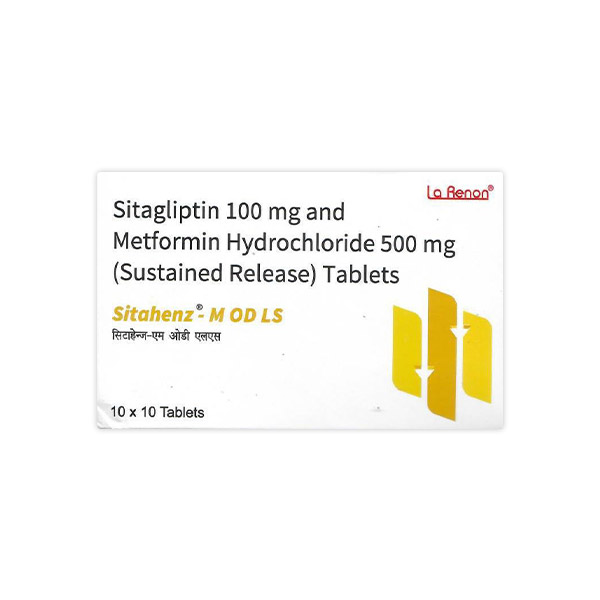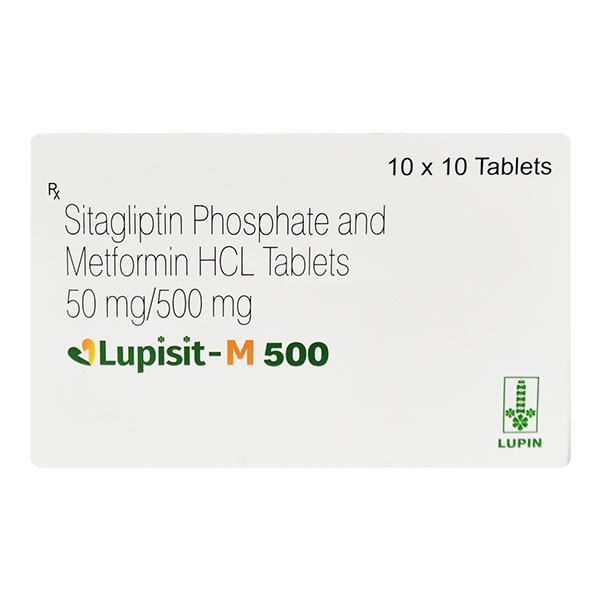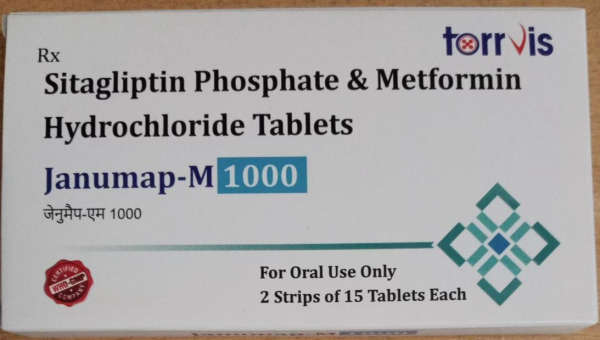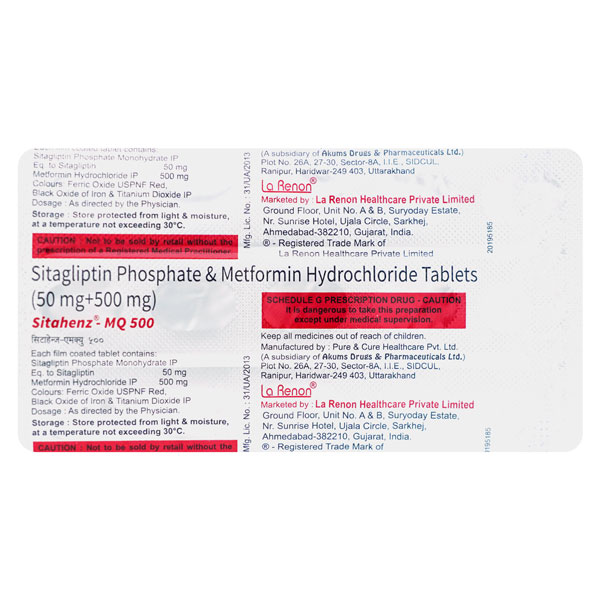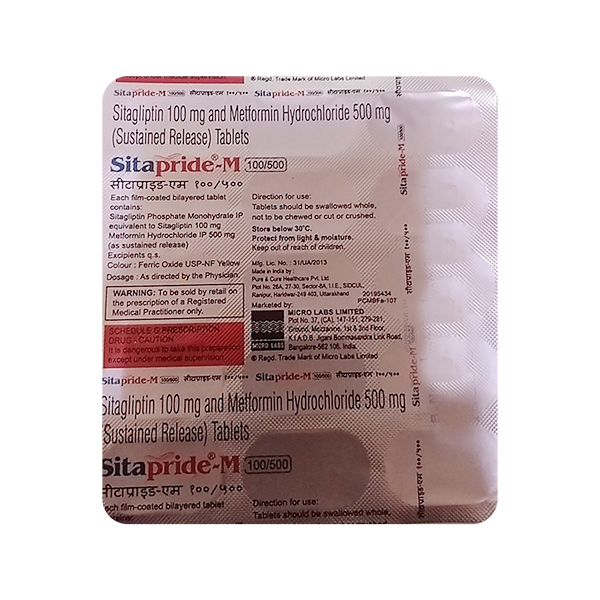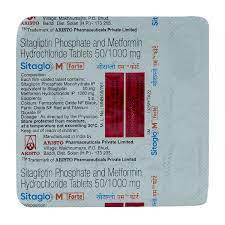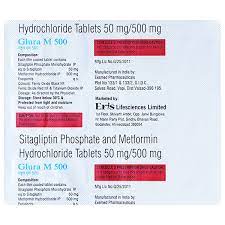Metformin + Sitagliptin
Find more information about this combination medication at the webpages for metformin and sitagliptin
Type 2 Diabetes Mellitus
Advisory
- This medicine contains a combination of 2 drugs metformin and sitagliptin.
- metformin and sitagliptin are both used to treat the same disease or symptom but work in different ways in the body.
- Most doctors will advise making sure that each individual medicine is safe and effective before using a combination form.
Drug Status

Government Approvals
US(FDA), UK(BNF)

WHO Essential Medicine
NO

Known Teratogen
NO

Pharmaceutical Class
None

Controlled Drug Substance
NO
Summary
Metformin and sitagliptin are used to manage type 2 diabetes, which is a condition where the body does not use insulin properly. Metformin is also sometimes used to manage polycystic ovary syndrome (PCOS), which is a hormonal disorder causing enlarged ovaries with small cysts. Sitagliptin is specifically used to improve blood sugar control in adults with type 2 diabetes. Together, they help manage blood sugar levels and improve overall diabetes management.
Metformin works by reducing the amount of sugar produced by the liver and improving the body's sensitivity to insulin, which is a hormone that helps control blood sugar levels. Sitagliptin works by increasing the levels of certain hormones that help the pancreas produce more insulin and reduce the amount of sugar made by the liver. Together, these medicines help lower blood sugar levels in people with type 2 diabetes, enhancing overall blood sugar control.
The usual adult daily dose of metformin can range from 500 mg to 2000 mg, depending on the individual's needs and how well they tolerate the medicine. It is often taken in divided doses with meals to reduce stomach upset. Sitagliptin is typically taken as a single daily dose of 100 mg, regardless of meals. The exact dose for each person may vary based on their blood sugar levels and response to treatment.
Common side effects of metformin include stomach upset, diarrhea, and nausea, which are related to its effect on the digestive system. Sitagliptin may cause side effects like upper respiratory tract infections, headaches, and sore throat. Both medicines can cause low blood sugar, especially when combined with other diabetes medications. Monitoring for these effects is important to ensure safe use of these medications.
Metformin should not be used in people with severe kidney problems, as it can lead to lactic acidosis, which is a serious condition where lactic acid builds up in the blood. Sitagliptin should be used with caution in people with a history of pancreatitis, which is inflammation of the pancreas. Both medicines should be used carefully in people with liver problems. It's important to monitor kidney and liver function regularly while on these medications.
Indications and Purpose
How does combination of metformin and sitagliptin work?
Metformin works by reducing the amount of sugar produced by the liver and improving the body's sensitivity to insulin, which is a hormone that helps control blood sugar levels. Sitagliptin works by increasing the levels of certain hormones that help the pancreas produce more insulin and reduce the amount of sugar made by the liver. Together, these medicines help lower blood sugar levels in people with type 2 diabetes, which is a condition where the body does not use insulin properly. This combination helps improve overall blood sugar control.
How does combination of Metformin and Sitagliptin work?
Metformin works by decreasing glucose production in the liver, improving insulin sensitivity, and enhancing peripheral glucose uptake. Sitagliptin, a DPP-4 inhibitor, increases the levels of incretin hormones, which enhance insulin secretion and decrease glucagon levels in response to meals. Together, they provide a comprehensive approach to managing blood sugar levels in type 2 diabetes, with metformin primarily targeting insulin resistance and sitagliptin enhancing the body's natural insulin response.
How effective is combination of metformin and sitagliptin?
Studies have shown that metformin effectively lowers blood sugar levels by reducing glucose production in the liver and improving insulin sensitivity. Sitagliptin has been proven to increase insulin production and decrease sugar production in the liver, helping to control blood sugar levels. When used together, these medicines provide a complementary effect, enhancing overall blood sugar control. Clinical trials have demonstrated that the combination of metformin and sitagliptin significantly improves HbA1c levels, which are a measure of long-term blood sugar control, compared to using either medicine alone.
How effective is combination of Metformin and Sitagliptin?
Clinical studies have demonstrated that metformin effectively lowers blood sugar levels by reducing hepatic glucose production and improving insulin sensitivity. Sitagliptin has been shown to enhance insulin secretion and reduce glucagon levels, leading to improved postprandial glucose control. When used together, they provide a complementary effect, improving overall glycemic control in patients with type 2 diabetes. The combination has been proven to significantly reduce HbA1c levels, a key indicator of long-term blood sugar control, in numerous clinical trials.
Directions for Use
What is the usual dose of combination of metformin and sitagliptin?
The usual adult daily dose of metformin can range from 500 mg to 2000 mg, depending on the individual's needs and how well they tolerate the medicine. It is often taken in divided doses with meals to reduce stomach upset. Sitagliptin is typically taken as a single daily dose of 100 mg, regardless of meals. The exact dose for each person may vary based on their blood sugar levels and response to treatment. It's important to follow the healthcare provider's instructions for dosing to achieve the best results.
What is the usual dose of combination of Metformin and Sitagliptin?
The usual adult daily dose for metformin is typically between 500 mg to 2000 mg, taken in divided doses with meals to minimize gastrointestinal side effects. For sitagliptin, the standard dose is 100 mg once daily. When combined in a single tablet, the dosage is adjusted based on the patient's current treatment regimen and tolerability, with a maximum of 100 mg of sitagliptin and 2000 mg of metformin per day. Both medications are used to improve blood sugar control in type 2 diabetes, but they work through different mechanisms, making them effective when used together.
How does one take combination of metformin and sitagliptin?
Metformin should be taken with meals to reduce stomach upset, while sitagliptin can be taken with or without food. It's important to take these medicines at the same time each day to maintain consistent blood sugar control. There are no specific food restrictions, but maintaining a balanced diet and regular exercise is recommended to help manage diabetes effectively. Patients should follow their healthcare provider's advice on diet and lifestyle changes to achieve the best results with these medications.
How does one take combination of Metformin and Sitagliptin?
Metformin should be taken with meals to reduce gastrointestinal side effects, while sitagliptin can be taken with or without food. Patients are advised to maintain a consistent diet and exercise routine to optimize the effectiveness of these medications. There are no specific food restrictions, but excessive alcohol consumption should be avoided as it can increase the risk of lactic acidosis with metformin. Regular monitoring of blood sugar levels is important to ensure the medications are working effectively.
For how long is combination of metformin and sitagliptin taken?
Metformin and sitagliptin are typically used as long-term treatments for managing type 2 diabetes. The duration of use depends on how well the medicines control blood sugar levels and the individual's overall health. Regular monitoring by a healthcare provider is important to assess the effectiveness and adjust the treatment plan as needed. These medicines are often part of a lifelong management plan for diabetes, which includes lifestyle changes like diet and exercise.
For how long is combination of Metformin and Sitagliptin taken?
Metformin and sitagliptin are typically used as long-term treatments for managing type 2 diabetes. The duration of use depends on the individual's response to the medication and their overall diabetes management plan. Both medications are intended for ongoing use to maintain blood sugar control, and they are often continued indefinitely unless contraindications or adverse effects arise. Regular monitoring by a healthcare provider is essential to ensure their continued effectiveness and safety.
How long does it take for combination of metformin and sitagliptin to work?
Metformin, which is a medicine that helps control blood sugar levels, usually starts working within a few days, but it may take up to two weeks to see the full effect. Sitagliptin, which is a medicine that helps increase insulin production, can start working within a few hours after taking it. When combined, these medicines work together to help manage blood sugar levels more effectively. However, the full benefits of the combination may take a few weeks to become noticeable.
How long does it take for combination of Metformin and Sitagliptin to work?
Metformin and sitagliptin work together to improve blood sugar control in people with type 2 diabetes. Metformin starts working within a few days, but it may take up to two weeks to see the full effect on blood sugar levels. Sitagliptin, on the other hand, begins to work within a few hours of taking a dose, as it helps increase insulin production and decrease glucose production in the liver. Together, they provide a complementary effect, with metformin primarily reducing glucose production in the liver and sitagliptin enhancing insulin secretion in response to meals.
Warnings and Precautions
Are there harms and risks from taking combination of metformin and sitagliptin?
Common side effects of metformin include stomach upset, diarrhea, and nausea, which are related to its effect on the digestive system. Sitagliptin may cause side effects like upper respiratory tract infections, headaches, and sore throat. Both medicines can cause low blood sugar, especially when combined with other diabetes medications. A significant adverse effect of metformin is lactic acidosis, which is a rare but serious condition where lactic acid builds up in the blood. Sitagliptin can cause pancreatitis, which is inflammation of the pancreas. Monitoring for these effects is important.
Are there harms and risks from taking combination of Metformin and Sitagliptin?
Common side effects of metformin include gastrointestinal issues such as diarrhea, nausea, and abdominal discomfort. Sitagliptin may cause upper respiratory tract infections, headache, and nasopharyngitis. Both medications can lead to hypoglycemia, especially when combined with other diabetes medications like insulin or sulfonylureas. Significant adverse effects include the risk of lactic acidosis with metformin and pancreatitis with sitagliptin. Patients should be monitored for these conditions and advised to report any unusual symptoms to their healthcare provider.
Can I take combination of metformin and sitagliptin with other prescription drugs?
Metformin can interact with medications like diuretics, which are water pills, and corticosteroids, which are anti-inflammatory drugs, potentially affecting blood sugar control. Sitagliptin may interact with digoxin, which is used for heart conditions, increasing its levels in the blood. Both medicines can interact with other diabetes medications, increasing the risk of low blood sugar. To manage these interactions, regular monitoring of blood sugar levels and adjusting medication doses as needed is important. Patients should inform their healthcare provider about all medications they are taking to avoid interactions.
Can I take combination of Metformin and Sitagliptin with other prescription drugs?
Metformin can interact with drugs that affect renal function, such as NSAIDs and certain antihypertensives, increasing the risk of lactic acidosis. Sitagliptin may interact with drugs that affect the DPP-4 enzyme, although significant interactions are rare. Both medications can increase the risk of hypoglycemia when used with insulin or sulfonylureas. Patients should inform their healthcare provider of all medications they are taking to manage potential interactions effectively.
Can I take combination of metformin and sitagliptin if I am pregnant?
Metformin is generally considered safe during pregnancy and is often used to manage gestational diabetes, which is diabetes that develops during pregnancy. It helps control blood sugar levels without causing significant harm to the mother or baby. The safety of sitagliptin during pregnancy is less clear, as there is limited data available. It is usually not recommended unless the potential benefits outweigh the risks. Pregnant women should discuss with their healthcare provider to determine the best treatment plan for managing diabetes during pregnancy.
Can I take combination of Metformin and Sitagliptin if I am pregnant?
Metformin has been used during pregnancy and is generally considered safe, with no clear association with major birth defects. However, sitagliptin's safety during pregnancy is not well established, and there is limited data on its effects. Pregnant women should discuss the potential risks and benefits of these medications with their healthcare provider. Managing blood sugar levels is crucial during pregnancy, and alternative treatments may be considered if necessary.
Can I take combination of metformin and sitagliptin while breastfeeding?
Metformin is considered safe to use during breastfeeding, as only small amounts pass into breast milk and it is unlikely to harm the baby. Sitagliptin's safety during breastfeeding is not well established, as there is limited information on its presence in breast milk and its effects on the infant. Therefore, caution is advised, and it is important for breastfeeding mothers to consult their healthcare provider to weigh the benefits and risks of using sitagliptin while nursing. Monitoring the infant for any adverse effects is also recommended.
Can I take combination of Metformin and Sitagliptin while breastfeeding?
Metformin is present in breast milk in small amounts, but it is generally considered safe for use during breastfeeding, as no adverse effects have been reported in breastfed infants. There is limited information on the excretion of sitagliptin in human milk, and its safety during breastfeeding is not well established. Therefore, caution is advised, and the potential benefits and risks should be discussed with a healthcare provider. Breastfeeding mothers should consult their doctor before using these medications.
Who should avoid taking combination of metformin and sitagliptin?
Metformin should not be used in people with severe kidney problems, as it can lead to lactic acidosis, which is a serious condition where lactic acid builds up in the blood. Sitagliptin should be used with caution in people with a history of pancreatitis, which is inflammation of the pancreas. Both medicines should be used carefully in people with liver problems. It's important to monitor kidney and liver function regularly while on these medications. Patients should inform their healthcare provider of any existing health conditions before starting these medicines.
Who should avoid taking combination of Metformin and Sitagliptin?
Metformin is contraindicated in patients with severe renal impairment due to the risk of lactic acidosis. It should also be used cautiously in those with liver disease or a history of alcohol abuse. Sitagliptin is contraindicated in patients with a history of pancreatitis. Both medications should be used with caution in elderly patients and those with heart failure. Patients should be informed of the symptoms of lactic acidosis and pancreatitis and advised to seek medical attention if they experience these symptoms.






.svg)

